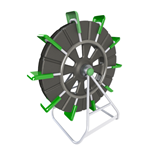
Hydro Powered Irrigation System to Enhance Food Security
Today, more than one billion people in the world suffer from hunger. The only sustainable solution to the problem of food scarcity is to increase food production in existing arable land. Improving irrigation in the developing world where such facilities are not available due to economic and topographic reasons can be an effective way to increase food production because proper irrigation can increase food productivity between two to five times that of normal production.
For areas where irrigation facilities have not reached farmers despite having a water source nearby, aQysta has developed an affordable and sustainable solution: Barsha Pumps. Barsha pumps are a hydro-powered irrigation system, a sustainable solution that does not use any external source of energy like fossil fuels or electricity and can be used to irrigate lands within 25 meters from a flowing water source. Farmers throughout Asia, Africa and South America have challenges irrigating despite being near a water supply.
Barsha pumps work on the spiral pumping principle – developed during ancient Egyptian times – but have never been applied on an industrial scale before. The kinetic energy of a river is used to rotate a water-wheel powered spiral, which pumps water by the alternating compression and decompression of air.
Barsha pumps are designed by optimizing the spiral pumping principle. They are crafted to be compact and easy to handle, with multiple spirals instead of one, which helps transport a greater volume of water. Modular design and only one moving part make Barsha pumps easier to standardize and maintain.
Apart from the product innovation, the business model in which we aim to implement the solution is also unique, involving local communities in manufacturing and maintenance of the irrigation systems which help to increase socio-economic prosperity in developing countries.
The major benefits of Barsha pumps are:
· Zero operating costs
· Two to five times greater agricultural productivity by providing year-round irrigation
· Return on investment for farmers within one year compared to approximately 10 years of diesel pumps
· Low maintenance due to only one moving part
· Zero Emissions: Barsha pumps produce zero emissions and replace fossil fuel pumps which produce 150-300 kg Co2 per hectare irrigated land per year.
Barsha pumps are about 1.5 meters in diameter and can pump water up to a height of 25 meters at a maximum flow rate of one liters/second. The pumps can be used as a stand-alone water pump to supply water to the field or can be combined with other complementary irrigation technologies like drip irrigation system and sprinkler irrigation system.
The target market for Barsha pumps are agricultural economies in Asia and Africa where more than 72 percent of world population live. In those regions, only 20-30 percent of the cultivable lands are irrigated and urbanization is increasing.
The primary market for aQysta is Nepal, a south Asian country where only 4.5 percent of land in the hilly area is irrigated year-round despite having more than 6,000 rivers across the country. More than 76 percent of the population in Nepal is dependent on agriculture, but most people do not have access to irrigation for topographic and economic reason. We have estimated a potential market of around 100,000 pumps in the country.
Currently aQysta is working with IDE Nepal to install Barsha pumps in six pilot locations in Nepal. The pilot project is expected to be finished by March 2013.
After Nepal, aQysta is planning to grow globally and have already received interest from countries like Sri Lanka, Rwanda, Mozambique, India and Ecuador.
Posted by Fred Henny, Satishkumar Sugavanam, Pratap Thapaprata on Dec 14, 2012